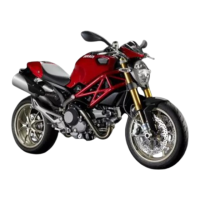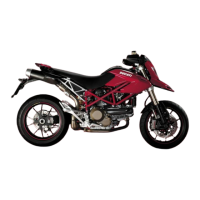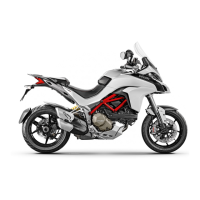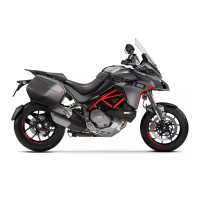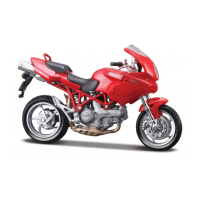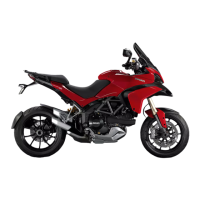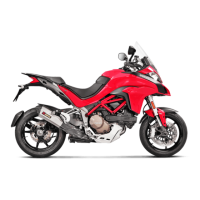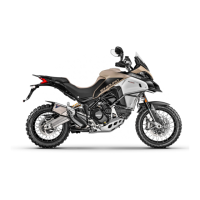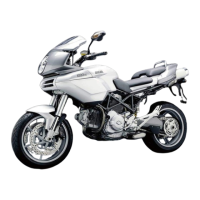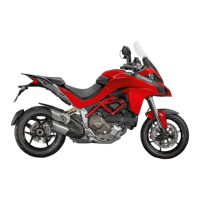Do you have a question about the Ducati MULTISTRADA 1100 S and is the answer not in the manual?
Details on motorcycle warranty terms, conditions, and invalidation.
Explanation of symbols used in the manual for warnings and notes.
Crucial safety advice before riding, covering rider conduct and vehicle precautions.
Details on maximum load capacity for rider, luggage, and accessories.
Location and importance of the motorcycle's frame and engine identification numbers.
Diagram and list identifying the location of key motorcycle controls.
Overview of the instrument panel's LCD and indicator lights.
Explanation of oil temperature, clock, speedometer, and auxiliary displays.
Description of warning lights, fuel level, and service indicator.
Procedure for instrument panel checks and parameter display modes.
How to set the clock and access trip meters, fuel, and speed data.
Explanation of odometer, trip counter, and fuel trip counter functions.
How current and average fuel consumption and remaining range are displayed.
Details on display backlight, warning light brightness, and auto-switch off.
Overview of the immobilizer system and the types of keys provided.
Explanation of the code card and how to override the immobilizer.
How the immobilizer system recognizes keys and operations for duplicate keys.
Details on the ignition switch positions and steering lock function.
Description of left/right handlebar controls, clutch, and brake levers.
How to operate the rear brake and gearchange pedals.
Procedure for adjusting the position of the gear and rear brake pedals.
Diagram showing the placement of major components on the motorcycle.
How to open and close the fuel tank filler cap.
How to use the passenger seat lock and helmet holder cable.
Guidelines for engine speed and brake use during the running-in period.
Essential checks before starting the motorcycle for safe operation.
Step-by-step guide to safely start the motorcycle's engine.
How to move off safely and proper braking techniques.
Procedure for removing and refitting fairing panels for maintenance.
Steps to remove and refit movable and fixed nose fairings.
How to check and maintain brake and clutch fluid levels.
How to check brake pads for wear using indicators.
Procedure for lubricating throttle cables, sidestand pivot, and drive chain.
How to adjust the throttle twistgrip free play.
Steps for safely removing, charging, and reinstalling the battery.
How to check and adjust the drive chain tension.
Procedure for changing high, low beam, and parking light bulbs.
How to replace bulbs in front/rear turn signals and number plate/brake lights.
Procedure for checking and adjusting the headlight beam aim.
Tyre pressure requirements and guidelines for repairing or replacing tubeless tyres.
Minimum acceptable tread depth for tyres and inspection advice.
How to check the engine oil level using the sight glass.
How to clean and check spark plugs for engine condition.
Guidelines for cleaning the motorcycle safely and preparing for storage.
List of maintenance tasks to be performed by authorized dealers.
Summary table of dealer operations and their service intervals.
Specifications for the motorcycle's overall dimensions and weight.
Recommended fluids and lubricants for the motorcycle, including quantities.
Details on engine specifications and the Desmodromic timing system.
Details on performance data, fuel system, and exhaust system.
Information on clutch, gearbox, and final drive ratios.
Detailed specifications for front and rear brake systems.
Details on the frame construction, wheel, and tyre specifications.
Specifications for suspension systems and available colours.
Overview of main electrical system components like lights, horn, and battery.
Location and function of the main fuse box and additional fuses.
How to identify blown fuses and replace them safely.
Key to the components and connections in the electrical system diagram.
Explanation of wire colour codes used in the electrical system.
Table detailing fuse positions, devices, and amperage ratings.
Instructions for reporting vehicle safety defects to the manufacturer.
Overview of exhaust, crankcase, and evaporative emission control systems.
Prohibitions against tampering with noise control systems and emission problems.
Essential safety advice for everyday motorcycle operation.
Importance of protective apparel and how to find the Vehicle Identification Number.
Description of the evaporative emission control system specific to California models.
Details of Ducati's limited warranty for emission control systems.
Logbook for recording scheduled maintenance services.
Details on motorcycle warranty terms, conditions, and invalidation.
Explanation of symbols used in the manual for warnings and notes.
Crucial safety advice before riding, covering rider conduct and vehicle precautions.
Details on maximum load capacity for rider, luggage, and accessories.
Location and importance of the motorcycle's frame and engine identification numbers.
Diagram and list identifying the location of key motorcycle controls.
Overview of the instrument panel's LCD and indicator lights.
Explanation of oil temperature, clock, speedometer, and auxiliary displays.
Description of warning lights, fuel level, and service indicator.
Procedure for instrument panel checks and parameter display modes.
How to set the clock and access trip meters, fuel, and speed data.
Explanation of odometer, trip counter, and fuel trip counter functions.
How current and average fuel consumption and remaining range are displayed.
Details on display backlight, warning light brightness, and auto-switch off.
Overview of the immobilizer system and the types of keys provided.
Explanation of the code card and how to override the immobilizer.
How the immobilizer system recognizes keys and operations for duplicate keys.
Details on the ignition switch positions and steering lock function.
Description of left/right handlebar controls, clutch, and brake levers.
How to operate the rear brake and gearchange pedals.
Procedure for adjusting the position of the gear and rear brake pedals.
Diagram showing the placement of major components on the motorcycle.
How to open and close the fuel tank filler cap.
How to use the passenger seat lock and helmet holder cable.
Guidelines for engine speed and brake use during the running-in period.
Essential checks before starting the motorcycle for safe operation.
Step-by-step guide to safely start the motorcycle's engine.
How to move off safely and proper braking techniques.
Procedure for removing and refitting fairing panels for maintenance.
Steps to remove and refit movable and fixed nose fairings.
How to check and maintain brake and clutch fluid levels.
How to check brake pads for wear using indicators.
Procedure for lubricating throttle cables, sidestand pivot, and drive chain.
How to adjust the throttle twistgrip free play.
Steps for safely removing, charging, and reinstalling the battery.
How to check and adjust the drive chain tension.
Procedure for changing high, low beam, and parking light bulbs.
How to replace bulbs in front/rear turn signals and number plate/brake lights.
Procedure for checking and adjusting the headlight beam aim.
Tyre pressure requirements and guidelines for repairing or replacing tubeless tyres.
Minimum acceptable tread depth for tyres and inspection advice.
How to check the engine oil level using the sight glass.
How to clean and check spark plugs for engine condition.
Guidelines for cleaning the motorcycle safely and preparing for storage.
List of maintenance tasks to be performed by authorized dealers.
Summary table of dealer operations and their service intervals.
Specifications for the motorcycle's overall dimensions and weight.
Recommended fluids and lubricants for the motorcycle, including quantities.
Details on engine specifications and the Desmodromic timing system.
Details on performance data, fuel system, and exhaust system.
Information on clutch, gearbox, and final drive ratios.
Detailed specifications for front and rear brake systems.
Details on the frame construction, wheel, and tyre specifications.
Specifications for suspension systems and available colours.
Overview of main electrical system components like lights, horn, and battery.
Location and function of the main fuse box and additional fuses.
How to identify blown fuses and replace them safely.
Key to the components and connections in the electrical system diagram.
Explanation of wire colour codes used in the electrical system.
Table detailing fuse positions, devices, and amperage ratings.
Instructions for reporting vehicle safety defects to the manufacturer.
Overview of exhaust, crankcase, and evaporative emission control systems.
Prohibitions against tampering with noise control systems and emission problems.
Essential safety advice for everyday motorcycle operation.
Importance of protective apparel and how to find the Vehicle Identification Number.
Description of the evaporative emission control system specific to California models.
Details of Ducati's limited warranty for emission control systems.
Logbook for recording scheduled maintenance services.
| Displacement | 1078 cc |
|---|---|
| Bore x Stroke | 98 x 71.5mm |
| Compression Ratio | 10.5:1 |
| Power | 95 hp (69.9 kW) @ 7750 rpm |
| Fuel System | Marelli electronic fuel injection, 45 mm throttle body |
| Transmission | 6-speed |
| Final Drive | Chain |
| Frame | Tubular steel trellis frame |
| Rear Suspension | Öhlins fully adjustable monoshock with progressive linkage |
| Rear Brake | 245 mm disc, 2-piston caliper |
| Front Wheel | 3.50 x 17 |
| Front Tire | 120/70 ZR17 |
| Rear Tire | 180/55 ZR17 |
| Seat Height | 850mm (33.5in) |
| Fuel Capacity | 20L (5.3 US gal) |
| Engine Type | L-Twin cylinder, 2 valves per cylinder Desmodromic, air cooled |
| Torque | 103 Nm (75.9 lb-ft) @ 4750 rpm |
| Exhaust | catalytic converter and lambda probe |
| Front Brake | 2 x 320 mm discs, 4-piston calipers |
| Rear Wheel | 5.50 x 17 |
| Front Suspension | Öhlins 43mm upside-down fully adjustable fork with TiN treatment |

